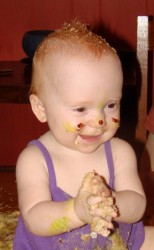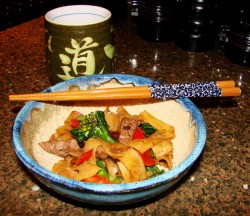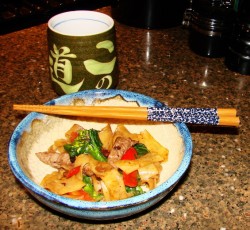Kat’s First Birthday: A Smashing Good Time
This is how Kat’s first birthday party started: a pretty new dress, a tranquil, clean, angelic looking baby, a clean table and lots of smiles all around.
This is how it ended: a nearly naked baby, a grinning, filthy goblin of a child, a sticky table, and giggling and laughter all around.
And it is all the fault of one thing, and one thing only.
A wicked, sinful, sugary confection made with lots of butter, flour, eggs and other such ingredients of dubious nutritive value. It is called a “birthday cake.”
I did not make Kat’s first birthday cake, and I know that for all those Martha Stewart worshippers out there, that is a grievous sin indeed. But hell, while I am perfectly capable of baking a beautiful and tasty genoise, filled with French, Swiss or Italian buttercream, or lemon curd or what have you, and topped with poured or rolled fondant or ganache, then decorated with gilt flowers and fruit, or icing swirls of intricate complexity, I don’t like doing it. That sort of baking gives me a headache, probably because I am a natural born cook, not a natural born baker. I prefer improvisation and the excitement of cooking “a la minute” as the French say–the thrill of a hot wok and a roaring flame and split second timing–to the extended planning, careful patience and diligence that an excellent baker must exhibit.
Instead, I made three different types of Chinese noodle dishes for the supper portion of the party (we called it the “oodles of noodles party–and if you are wondering, I made ja jiang mein, Hunan cold spicy noodles, and cold sesame peanut noodles) and ordered two cakes from The Village Bakery, which sits at the bottom of our hill, where they use fresh, local ingredients and actually make cakes with actual ingredients like real butter and organic wheat flour, maple syrup, raw sugar, fresh fruits and the like. The folks down at the bakery are awesome, and their food is something I do not mind letting Kat eat–whereas the typical bakery products made of hydrogenated vegetable oil and preservatives are not ever on my list of foods for a baby to eat.
But why two cakes?
My family is one of those who allow babies to experience their first taste of a sweet by completely and utterly destroying their first birthday cake.
Some families do not do this, and some people are offended by this practice, but I think it is a fun way to allow a kid to have a first culinary indulgence. I guess folks are offended by the waste of the cake–but, well, in Kat’s case, she only really got half of the smaller cake–we rescued and served the other half, along with the other whole cake which was meant for the guests and family of the birthday child. (I can understand the waste of food issue, but I cannot help but have fun with a kid tasting something sweet for the first time, and really getting into it–literally. It is too much fun to begrudge the little one a cake.)
As you can see–Kat wasn’t sure of what to do with the cake. Morganna had to take matters in hand and help her out with a first little taste.
Some might wonder why I spent so much money for a really good cake if Kat was going to mash it up.
My reasoning is this: she is going to eat a good amount of the cake, and I would rather that the fat and sugar calories she ingests by eating cake come from real honest to god ingredients that are at least partially good for her rather than nasty fake stuff that is in no way shape or form anything but bad.
And I was not about to make her a “healthy” first birthday cake, either–I read some of those recipes online and they seemed gross. No, for me, cake is not cake unless it is an indulgence–it should be fattening and sweet and oh so delicious–not healthy! It isn’t like Kat or anyone else is going to be eating birthday cake every day, so why try and make it healthy?
In other words, birthday cake should be good, and while not necessarily good for you, it should at least be made from good ingredients, not crap.
And in the case of a first birthday cake–it should be smashing good.
Now we come to a real connoisseur of birthday cake: Grandma Tessa. Here you see her coaxing Kat along with a taste of icing and encouraging words.
Tessa loves birthday cake, and generally, she likes the kind of inexpensive cake that comes from grocery store bakeries which I eschew. She likes the hydrogenated vegetable oil shortening and sugar icing, and can eat inordinate amounts of it. I think she has a pancreas of iron, and she is really funny to watch after eating it, because she has the metabolism of a hummingbird and will fly around the room afterwards on the power of all that sugar. If you give her coffee, too, whoa. You really have to watch out. Cake and coffee are rocket fuel for Tessa.
So, be warned that if you come to my house sometime, and you hear a vibratory hum and feel a wind whoosh past you and see a vaguely red-headed blur out of the corner of your eye–don’t worry–it isn’t a giant mutant hummingbird or a new species of Mothman. It is probably just Tessa flitting past after powering up on cake and coffee. You won’t have to worry about her running you down, though–she is way too nice for that. The worst that will happen is that she will hug you and show you her new shoes. (Tessa is also well known for her love of shoes in addition to cake and coffee.)
Kat finally got into it, after some coaxing, and started picking out bites for herself, though the first ones were relatively demure and not very messy. Kat is a remarkably neat eater for such a wee baby, so at first, she mostly got cake into her mouth where it belonged. She liked both the icing and the cake, and she was particularly fond of the raspberry preserve filling. I noticed a lot of lip smacking when she dug into that.
I was told by my mother and grandmother that I was similarly shy with my first birthday cake, and would only touch one finger to it at first. However, once I got a good fingerful of icing, I apparently lost all reserve and control and simply leaped face forward into the cake, and ended up with cake in my ears, in my hair, my socks, shoes, down my shirt and everywhere else it was possible for it to get. Mom just dunked me clothes and all in Gram’s big bathtub and bathed me and washed clothes at the same time. Not a bad idea, really.
Like mother, like daughter–here Kat prepares for an open-mouthed-face-dive into the cake. This would be after Morganna started painting icing “war paint” onto Kat’s nose and cheekbones. Once we all encouraged her, she really got into it and started a full-body assault on the cake. Meanwhile, I cut and served the other cake–lemon cake with lemon curd filling and lemon icing–and passed it around to our friends and family. All of us just sat around and watched Kat give herself over to an orgy of cake desecration. She even ended up making a throne out of part of the cake and sitting on it.
Not satisfied with her own cake to destroy, Kat wriggled over to where I was minding my own business, eating my piece of the lemon cake. Before I caught her intention with my psychic mother senses, she reached out and swiped my piece from my plate and hugged it to her belly as if trying to push it into herself via some mystic osmotic process. I had to admit that the Force was with Kat and her kung fu was greater than mine amid the gales of laughter as Kat beamed her best mischievous goblin grin at me, a new jag of tooth barely showing in her bottom gum.
She ended up with cake in her hair, which Morganna could not resist using as a styling product so as to make a “baby mohawk” do for her little sister. It looked good on Kat, and it was wonderful fun watching the two sisters feed each other cake with sticky fingers, laughing and giggling like a pair of insane pixies. They were enjoying each other and taking pleasure in not only eating food, but glorying in it.
I think that is why I like the tradition of letting babies smash up their first birthday cakes.
It is refreshing to see someone explore food so wholeheartedly, without shame or fear or guilt. Americans have so many food hangups and weirdnesses that it is amazing to see a child explore something like a cake for the first time, not just in the socially prescribed, proper ways, but in every way possible. Kat not only tasted the cake, and rolled it around on her tongue, mashing it against the roof of her mouth and swallowed it. She -lived- the cake. She was free to squish the icing between her fingers and explore the differing textures of icing and cake and filling. She had the sensual pleasure of rubbing vanilla scented buttercream all over her skin (and boy was her skin soft, even after her bath–and she still smelled of butter and vanilla, too, btw–yummy baby!), and she even got her toes into the act, as she used her feet to grab at the cake, icing squishing between her toes.
Seeing that innocent, unfettered joy, that gustatory and sensual delight in food was not a waste of anything–not time, not money and not a cake.
It was a treasure.
Eating Local 2007: What Does Halal Mean?
After posting my essay on the subject of eating locally as a spiritual practice, I thought it would be nice to feature some posts by other authors that describe their personal experiences and thoughts on the intersection between food and spirituality in their own lives.
And then, I promptly got involved in making noodles, playing with Kat, planning a little first birthday get together for her and getting my new laptop up and running, and sadly forgot.
So, then I sat down at my laptop today and saw to my surprise that my friend Heather, who is not only an articulate and precise writer, is also a devoted Muslim and a scholar of Islam. Her essay is so good, I really want you all to go to her blog and read it, because not only does it explain the Islamic laws governing how meat animals are to be treated, it is a critical look at how this is practiced in today’s world. Heather gives us her own personal interpretation on the practice of halal and how she works, as a consumer, to promote healthier, cleaner and more human practices of animal husbandry.
Heather and I have had long conversations in the kitchen and dining room over the shameful state in which most meat animals are raised and treated in this country, and what we as consumers can do about it. We’ve also traded books back and forth, ideas and recipes, so I was thrilled to see that she had finally put all of her thoughts in regards to the subject on her blog this morning. (And I hope to see more of her writings in the future, because she is such a good writer and her point of view is both unique and relevant, that I want to see her get her thoughts out there.)
So, without further ado, let me introduce my friend Heather Irwin, and her essay, “Is Halal Meat Halal? (or, Why I Care About a Cow?)
Fun With Chow Fun
Chow fun is a transliteration from the Cantonese, which means “stir-fried rice noodles;” the Mandarin transliteration would be “chao fen.” It does not have anything to do with the English slang word, “chow,’ meaning “food” and “fun”, meaning “fun.” No, it does not mean “food that is fun,” though I do think it is fun to eat and now I am pretty sure it is fun to cook, too.
The Cantonese name is the one by which this dish is most commonly known in American Chinese restaurants, however, in large part because the first waves of Chinese immigrants to the shores of the United States came from Guangdong Province, formerly known as Canton. Thus, much of what many Americans think of as “Chinese” food is Cantonese food that has been adapted to Western tastes and available ingredients; the deep influence of Cantonese cuisine upon our perceptions of the myriad cuisines that make up Chinese food in the US is hard to overstate.
Chow fun is one of the dishes that is often found on Chinese restaurant menus here in the US, and it is properly made with soft, fresh rice noodles cut into 1/2 to 3/4 inch widths. These noodles, known in Cantonese as “ho fun” or “hor fun,” and in Mandarin as “shahe fen” or “he fen”, are soft, chewy and have a special stretchy texture which is distinctive and very interesting on the tongue. Most restaurants use a great deal of oil in cooking these noodles, because in part, they require a good bit of lubrication to keep them from sticking to a hot wok. They can be served either “dry” where they are cooked with a meat and vegetables and no sauce to speak of, or “sauced.” where the noodles, meat and vegetables are moistened with a savory sauce.
I prefer the sauced version myself, as I have found that the unsauced noodles to be a bit too greasy feeling for my taste, but there are others who swear that the dry versions are best.
A classic Cantonese teahouse dish is chow fun made with beef, mushrooms and bean sprouts, stir fried in a light sauce. It goes very well with pu er tea; a fermented, aged tea that has an earthy, deep aroma and flavor that goes very well with rich foods. It is said to help the digestion and it is believed to help lower cholesterol, though I have not seen any peer reviewed articles on that particular claim in any medical journals, so don’t take my words as gospel truth.
My very favorite version of it is the decidedly untraditional but delicious one at Noodles Corner in Columbia, Maryland, with beef, fermented black beans and broccoli. It is delicious, filled with the bittersweet savor of the broccoli and the strong flavor of the beef, tied together with the funky and fantastic aroma of the fermented black beans.
I have to admit to making my version of chow fun with half inch wide dried rice noodles; fresh rice noodles of the type used to make real chow fun are nearly impossible to come by in my section of Ohio. I was concerned about that, thinking that I wouldn’t be able to make a good chow fun without the proper fresh noodles, but none other but cooking teacher and cookbook author Florence Lin said that she preferred dried rice noodles to fresh because they were more consistent and versatile to work with. She gave a chow fun recipe in her seminal work, made with rehydrated rice noodles. Taking my cue from her experience and wisdom, I decided that just because I couldn’t get proper ho fun, didn’t mean I couldn’t have fun with making my own chow fun at home.
I decided to eschew the traditional mushrooms and bean sprouts since Zak doesn’t care for either of them and replace them with gai lan and sweet red pepper. This would approximate the flavor and color palette of my favorite chow fun at Noodles Corner while using my favorite Asian vegetable of all time–gai lan is the best green in the world, as far as I am concerned. I kept the fermented black beans in the dish, and added onions, garlic, ginger, a single fresh chili from my Kung Pao chili pepper plant, and a good amount of ground bean sauce to the aromatics in the stir fry. These combined to make the noodles rich with umami scent and flavor, with tender beef, crunchy gai lan stalks and pepper slices, and velvety gai lan letaves.
Though the noodles lacked the slightly stretchy, chewy quality that fresh ho fun have, they were still wonderful, soft and slippery, soothing and yet still toothsome ribbons that carried the other flavors beautifully, contrasting with all the other textures like a symphony in the mouth.
When the dish was done, I was pleased to discover that I could use much less oil than traditionally called for in the cooking of the fresh noodles, which lightened the finished flavor considerably. Al though my first impulse was to call these noodles “faux chow fun,” I changed my mind and called them “fun chow fun” because I liked playing with the homophones which have different meanings but still point to a singularly good kitchen experience.
Lighter it may have been, but Zak and I discovered that this version of beef chow fun still went hand-in-hand with pu er tea. The dark forest flavor and scent of the tea cut through the vivid flavors of the noodles, cleansing the palate and allow us to savor each bite as if it were our first.
Ingredients:
1/2 package of 1/2″ wide flat dried rice noodles
water as needed
1/2 pound top round or sirloin, cut into thin strips–2″X1/2″X1/4″
1 tablespoon dark soy sauce
1 tablespoon Shao Hsing wine
1 teaspoon raw or brown sugar
1 tablespoon cornstarch
3-5 tablespoons peanut or canola oil
1 cup thinly sliced onion
3 cloves fresh garlic, peeled and thinly sliced
2″ cube fresh ginger, peeled and sliced thinly
1 fresh red chili pepper, thinly sliced on the diagonal (optional)
2 tablespoons fermented black beans
2 heaping tablespoons of ground bean sauce
1/2 pound gai lan, bottoms trimmed, stalks cut into thin slices on the diagonal, leaves cut into bite sized chunks
1 small sweet red pepper, cut into slices the same size as the beef
1 tablespoon dark soy sauce
1/4-1/2 cup chicken broth or stock (I used the chicken-pork stock I made last week–it really tasted good here!)
1 teaspoon toasted sesame oil
Method:
Soak the noodles in very hot water to cover until they soften–about on half hour to forty-five minutes.
Bring a pot of water to boil, and add noodles. Allow to boil for a mere thirty seconds, then drain. Rinse well in hot water, then cold water, and fluff with hands coated in a bit of your cooking oil to keep them from sticking to each other.
Mix beef with next four ingredients and allow to marinate while doing other prep work–marinate at least twenty minutes, but no more than an hour.
Heat wok until it smokes. Add three tablespoons of oil–leave the rest of the oil to be used only if you need it.
Add onion and cook, stirring, until it browns lightly. Add garlic, ginger, chili and fermented black beans, and cook, stirring, for another thirty to sixty seconds, or until very fragrant. Add beef all in one layer in the bottom of the wok, and leave it undisturbed for about a minute to brown on the bottom. Then begin stir frying vigorously. When most of the beef is brown and is showing very little red, add the ground bean sauce and the soy sauce. Stir and fry for another thirty seconds, then add gai lan.
Cook, stirring until leaves wilt. Add sweet pepper and drained noodles. Add smaller amount of stock or broth and cook, stirring, until the meat is brown, the gai lan leaves are well-wilted, the noodles are well-mixed and starting to brown a bit and curl on the edges, and everything comes together in a very light brown sauce that coats everything evenly, but does not slosh around in the wok. If you need to add more oil or broth to the noodles to keep them from sticking, do so, but do it in small increments. You don’t want to make the noodles either greasy and heavy with oil or overcooked and mushy with the broth, so be sparing in your additions. I only used three tablespoons of oil and a scant quarter cup of broth in my chow fun, and it turned out really well. Be judicious.
When dish has come together, drizzle with sesame oil, give it a quick stir or two to combine and scrape into a serving bowl or platter.
This makes enough for 2-4 people, depending on appetite and whether or not you are serving other dishes with this as a meal. With this as a one dish meal, Zak and I ate comfortably, and there was enough left over for Morganna to take to school for lunch the next day. It is good at room temperature, or reheated in the microwave.
Computer System Update
Hey, folks!
My new laptop which will be replacing my old desktop and ancient/pathetic/falling-apart/held-together-with-duct-tape laptop came today. Zak will be transferring files, setting up, transferring photographs and all that stuff for the next day or so.
That means no posts for a short while.
But, what that also means is that there will be fewer delays in posting -after- all of this is done. Because basically, my two old computers were just barely limping along and were tiffing with each other and not talking with each other and being general pains in the butt. So, for my birthday, a new laptop has come into my life.
So, be patient. There will be new posts soon, showcasing recipes like Beef Chow Fun (Cantonese style stir fried beef and wide rice noodles–I made it for the first time last night–oh, WOW!), Hunan beef rice noodle soup and other goodies such as that.
Also, Kat’s first birthday is coming up, so look for a picture or two of her eating cake for the first time.
And, I do have an essay or two or four planned for the upcoming weeks, and a few reader requests of recipes to post about. So–look for good things in the near future, and until they happen, be patient, read my archives, and check out some of the fantastic writers in my blogroll off to the right there. Lots of goodies to be found there, I promise!
The Buzz on the Bees
Scientists seem to have unraveled at least part of the mystery of colony collapse disorder: a virus called “Israeli acute paralysis,” which seems to have entered the US by way of Australia. This theory is fueled by the fact that CCD was first reported in 2004, the first year that the US government allowed imports of honeybees from Australia since 1922. It seems that the virus came with the Australian bees, which have developed an immunity to it, and then affected American bees, which had no immune system defenses against it.
Every article I have read on the subject has entomologists quickly pointing out that even if this virus is contributing to the problem of CCD, it is not the -only- issue at hand; it is still probably only a co-factor along with one or more other contributing factors in this perplexing agricultural problem. It is possible that this virus, combined with a known Asian bee parasite, nosema ceranae is causing CCD; it is just as likely that there are other factors at work as well.
It is a complex problem, one for which no simple answer is in sight. I do hope that this revelation of a possible viral component to the disease will help us find at least a partial solution to the problem of massive bee die-offs, but I do wonder about the state of science education in the USA when I read questions such as the ones found on MSNBC’s “Cosmic Log.” There a reader asked, “I was wondering if there in any research on possible effects to humans. I personally take bee pollen every day for vitamins, minerals, amino acids, energy, etc. Believe it or not, I also take it as a possible antivirus [measure].”
The author of the MSNBC blog was much kinder in his answer than I was in my head when I read it–I remember being taught in high school biology that viruses tend to be species-specific: the viruses that give your cat a cold will not affect you. While viruses rapidly mutate and some can cross-infect among different species (think Avian flu or rabies), the likelihood of the honey of infected bees being a danger to humans is quite minimal. I figured that everyone knew that.
Apparently not. In this day and age of the media pumping Americans full of fear regarding the natural world with terror tales of West Nile Virus, Avian Flu and dying bees, I guess it is no wonder that consumers might worry about eating honey.
Personally, I think folks need to worry more about eating microwave popcorn twice a day than eating honey. But, that is my own bias–I cannot abide the smell of the artificial butter flavor from that product, and am not surprised to find out it can destroy your lungs. It certainly smells evil to me.
(Thank you to Brother Thomas for sending me the note about the bees which inspired this post.)
Powered by WordPress. Graphics by Zak Kramer.
Design update by Daniel Trout.
Entries and comments feeds.
















